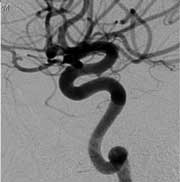An innovative device that could save the lives of patients with complex brain aneurysms is being recommended for use among NHS patients.
The National Institute of Health and Clinical Excellence (NICE) has this week issued new guidance recommending use of the Pipeline embolisation device manufactured by Covidien.
The document supports use of the device in patients with giant or complex intracranial aneurysms who would need large numbers of coils during traditional stent-assisted coiling and who are unsuitable for neurosurgical treatment.
The recommendation is based on evidence showing the device could save the NHS around £500 per patient compared with standard treatments and reduce the need for follow-up procedures and the possibility of life-threatening haemorrhages.
An aneurysm is a bulge in a blood vessel caused by a weakness in the vessel wall. If an aneurysm in the brain ruptures, the resulting haemorrhage can cause death or serious brain damage. The condition currently affects around 1 in 12,500 every year in England alone.
A self-expanding blood flow diverter that is placed across the neck of an intracranial aneurysm, the Pipeline device maintains blood flow through the parent vessel while disrupting flow within the aneurysm sac itself, leading to stagnation and eventual thrombosis formation. The technology provides a scaffold for endothelial growth, leading to the formation of a biological seal and exclusion of the aneurysm from the circulation.
A braided, cobalt chromium and platinum stent-like device, it is loaded into and delivered via a microcatheter and is currently manufactured in lengths of 10-35mm with diameters in 0.25mm increments from 2.5-5mm. Multiple devices can be used within each other or in sequence to increase the overall length of the construct or to increase the metal surface coverage within an aneurysm.
The NICE guidance indicates it for use in patients with complex giant or large intracranial aneurysms when the number of Pipeline embolisation devices inserted does not exceed two, and when treatment would otherwise require the use of 32 or more coils combined with one stent for stent-assisted coiling. If two Pipeline embolisation devices are used, the total procedure cost is estimated as £30,346 compared with £30,838 for the use of 32 coils for stent-assisted coiling.

An aneurysm six months after treatment with the Pipeline technology
Claimed benefits include a higher rate of permanent occlusion of aneurysms compared with coiling and stent-assisted coiling, increased access for patients with complex conditions, a resolution of neurological symptoms, and increased long-term vessel patency.
Professor Carole Longson, director of the NICE Health Technology Evaluation Centre, said: “The independent NICE Medical Technologies Advisory Committee reviewed the evidence for adopting the Pipeline embolisation device in the NHS and concluded that it has benefits for patients. In some clinical scenarios, using Pipeline is expected to save the NHS around £492 per procedure compared with standard treatment.”
And she appealed to clinicians using the device to submit details of all patients treated to the UK Neurointerventional Radiology Group audit database where research is continuing. This will increase the evidence base and help guide future use of the technology.”
To read the full guidance, click here.




